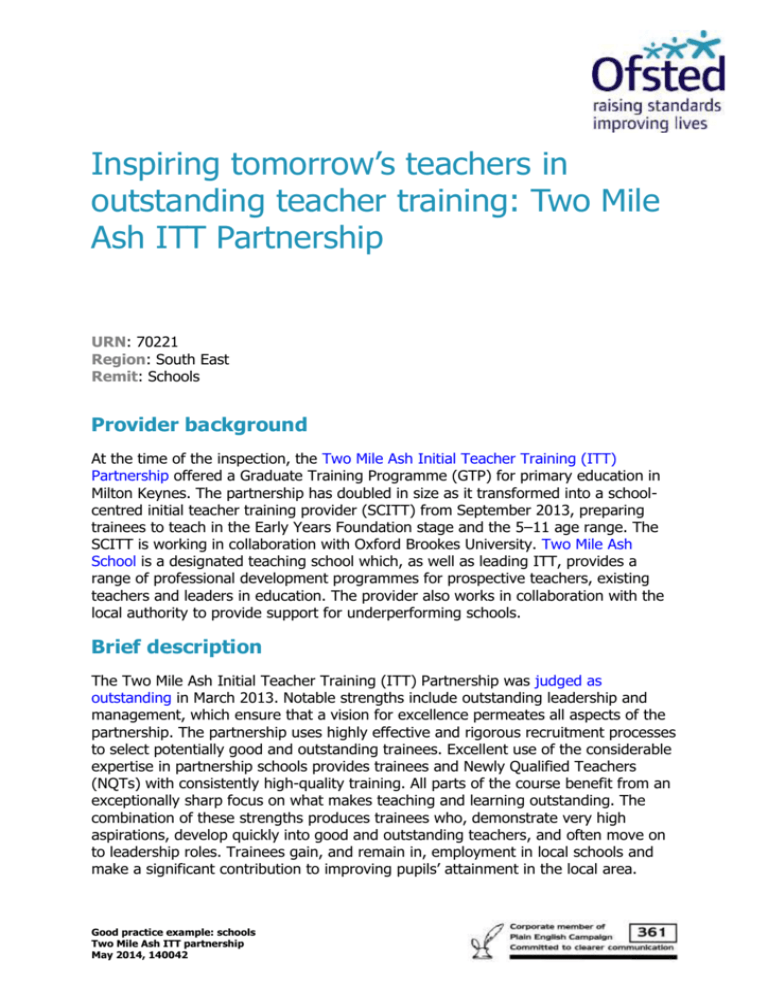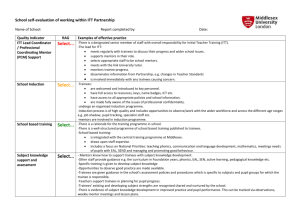Two Mile Ash ITT partnership
advertisement

Inspiring tomorrow’s teachers in outstanding teacher training: Two Mile Ash ITT Partnership URN: 70221 Region: South East Remit: Schools Provider background At the time of the inspection, the Two Mile Ash Initial Teacher Training (ITT) Partnership offered a Graduate Training Programme (GTP) for primary education in Milton Keynes. The partnership has doubled in size as it transformed into a schoolcentred initial teacher training provider (SCITT) from September 2013, preparing trainees to teach in the Early Years Foundation stage and the 5–11 age range. The SCITT is working in collaboration with Oxford Brookes University. Two Mile Ash School is a designated teaching school which, as well as leading ITT, provides a range of professional development programmes for prospective teachers, existing teachers and leaders in education. The provider also works in collaboration with the local authority to provide support for underperforming schools. Brief description The Two Mile Ash Initial Teacher Training (ITT) Partnership was judged as outstanding in March 2013. Notable strengths include outstanding leadership and management, which ensure that a vision for excellence permeates all aspects of the partnership. The partnership uses highly effective and rigorous recruitment processes to select potentially good and outstanding trainees. Excellent use of the considerable expertise in partnership schools provides trainees and Newly Qualified Teachers (NQTs) with consistently high-quality training. All parts of the course benefit from an exceptionally sharp focus on what makes teaching and learning outstanding. The combination of these strengths produces trainees who, demonstrate very high aspirations, develop quickly into good and outstanding teachers, and often move on to leadership roles. Trainees gain, and remain in, employment in local schools and make a significant contribution to improving pupils’ attainment in the local area. Good practice example: schools Two Mile Ash ITT partnership May 2014, 140042 This is part of a set of eight examples showcasing good practice in initial teacher education. The good practice in detail The partnership recognises that the overarching factor in determining the quality of teachers is how well they promote pupil progress and secure children’s learning. The partnership believes that the same applies to trainee teachers and that newly qualified teachers will be substantially disadvantaged if they do not have a true sense of what good learning looks like in their classrooms. These are exceptionally high expectations and trainees need to make significant progress during the 10 months of the programme if they are to ‘This course has been the demonstrate this in their teaching. Ensuring that everyone in the partnership has an excellent understanding of the difference between ‘doing’ and ‘learning’; and between ‘engagement’ and ‘progress’ is vital to achieve this ambition. most demanding, but the most rewarding thing I have ever done and has been the best preparation I could have had for taking my own class.’– Programme leaders compared approaches to Former trainee lesson observation with a number of other providers in order to develop their own system. They wanted to make sure that the ITT requirements were met, the relevant data collected, and most importantly, that pupil learning was at the heart of any feedback the trainees received. ‘The fact that five of our nine full-time class teachers are ex-TMA trainees shows that we totally rate the quality of training!’– Headteacher The Framework for school inspection criterion for teaching and learning was integrated into the process. The concept of pupil-focused feedback was introduced and all school-based trainers received training to be able to apply these criteria to the trainee teachers’ lessons. Conversations about pupil learning increased and discussions about what trainee teachers had ‘delivered’ decreased. School-based trainers became more confident and accurate in measuring pupil progress, delivering formative feedback and making judgments about the quality of lessons using the lesson observation record. This sharp focus on pupils’ learning was noticeable during the inspection. Mentors and trainees used questions such as: Where in the lesson could children have made more progress? Was this true for all children or particular groups? How could that have been achieved? What do you need to do now to make sure that there is greater learning in your next lesson? 2 Good practice example: schools Two Mile Ash ITT partnership May 2014, 140042 This directed the trainees’ focus onto the pupils’ learning and increased their motivation to improve their teaching skills, helped by the lesson planning form. In order to keep up the momentum and deepen the reflection on learning, the partnership collaborates with an external consultant who supports schools nationally in increasing their focus upon learning. This collaboration has involved, over the years: moderation of lesson judgments adapting documentation professional coaching of programme leaders training of quality assurance representatives and school-based trainers the introduction of innovative approaches to promote trainee teachers’ learning (as well as that of the pupils). This has kept learning as the top priority and has been a key factor in the increasing numbers of trainees graded as outstanding. It is also noticeable that most of the long-standing schools in the partnership maintain significantly high pupil attainment and, in many, standards have risen during their involvement in the ITT partnership. Choosing and using expertise The partnership schools are the most important aspect of the provision. Their combined strengths are used to provide excellent training opportunities and their commitment to creating the very best teachers for partnership schools means that employment rates are exceptionally high. The partnership has strict selection criteria for its schools. Inspection reports are scrutinised to gain a full picture of the strengths of the school, as well as the areas requiring improvement. Placements are discussed to ensure that trainees are learning from highquality role models. The Head of ITT carries out a detailed interview and tour of the potential school partner with the headteacher to gather information about the school Good practice example: schools Two Mile Ash ITT partnership May 2014, 140042 3 and a school profile form is completed. Headteachers update these on an annual basis and the profiles are used to gain an in-depth understanding of each school in the partnership. This informs both home/school and crossphase placement decisions and enables the partnership to identify specialist expertise to contribute towards the core training. Partner headteachers meet once every term to support ongoing evaluation and priority setting. In the spring term they discuss where the expertise will come from in order to shape the training programme for the following year. There is an openness which allows the partnership to recognise where existing training is of high quality or where ‘A strength in the improvements are needed, as well as providing programme this year has opportunities for new contributors to step been the focus on learners, which has helped forward. my trainee to see more clearly what he needs to do next and how to progress his own development.’ – School- The structure of the partnership means that partner school headteachers are actively involved in the Strategic Board. School colleagues are members of the influential and very effective Quality Assurance and Monitoring based trainer group. Schools put forward members of their teaching staff to run training sessions and also offer their schools as venues to provide whole cohort training and master classes on specific areas of focus. Partnership schools invest this time, energy and involvement because they know that the benefits of being involved are far greater than the token financial remuneration they receive. An aspect of this approach that is particularly noteworthy is that almost half of the schools support whole-cohort training. This includes: expert-led investigation into teaching strategies that support the learning of children who have special educational needs social inclusion workshops on how to promote good pupil behaviour curriculum and creativity master classes learning environment analyses. Not only does this equip the trainee teachers with the necessary skills to increase the effectiveness of their teaching, but it also exposes them to the rich diversity of local schools. In seeking employment, trainees are ‘This course inspires the encouraged to be selective. Schools differ in trainees to be the best!’ – their ethos and approach while proving themselves equally effective. The partnership School-based trainer supports trainees to become increasingly aware of their emerging teacher identity, and to use this to find a good match with a school for their NQT year. This contributes to sustained high retention rates. 4 Good practice example: schools Two Mile Ash ITT partnership May 2014, 140042 The wider influence of the partnership Two Mile Ash School grasped the opportunity to become the lead school in a Teaching School Alliance. This was seen as a natural progression from their collaborative approach to the Initial Teacher Training Partnership. The leaders saw how the partnership’s vision for raising pupil outcomes across the collection of schools could be supported to an even greater extent by driving the ‘Big Six’ across a wider alliance. As a result of the Teaching School initiative, central trainers from partnership schools have become Specialist Leaders of Education. School-based trainers have taken part in the partnership’s Outstanding Teacher Programme. Action research groups have disseminated their findings to trainee teachers. Teaching staff have been deployed to support colleagues in schools where standards have not been sufficiently high. Through staff reflecting on these experiences, this has become a mutually beneficial experience. A deeper selfconfidence and expertise has been generated in those returning to their schools. Resources have been shared, building capacity for professional development across both the ITT Partnership and the Milton Keynes ‘Training inspires Teaching School Alliance. Liz Airlie, Head of ITT summarises their success: ‘The greatest impact of the Teaching School work has been how the connections between the various opportunities have strengthened the overall quality of provision.’ trainees to be inspirational, with a focus on learning.’ – School-based trainer Other good practice examples in this set Alban Federation London East Consortium, University of Cumbria Stockton-on-Tees Teacher Training Partnership Suffolk and Norfolk Primary SCITT Two Mile Ash ITT Partnership University of Durham – primary University of Durham – secondary Wakefield Regional Partnership for Initial Teacher Training Good practice example: schools Two Mile Ash ITT partnership May 2014, 140042 5 The good practice case studies that Ofsted publishes highlight specific examples of practice that providers of education, learning and children’s services have used to achieve successful outcomes. For education, the case studies do not recommend a single particular approach to teaching and learning. Ofsted has no preferred lesson structure or teaching style. We showcase and share a wide range of approaches that providers have found work well for them in achieving good outcomes for children, young people and learners. Are you thinking of putting these ideas into practice; or already doing something similar that could help other providers; or just interested? We'd welcome your views and ideas. Get in touch here. To view other good practice examples, go to: www.ofsted.gov.uk/resources/goodpractice. If you would like a copy of this document in a different format, such as large print or Braille, please telephone 0300 123 1231, or email enquiries@ofsted.gov.uk. 6 Good practice example: schools Two Mile Ash ITT partnership May 2014, 140042





